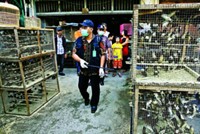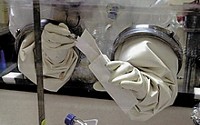Advertisement
Grab your lab coat. Let's get started
Welcome!
Welcome!
Create an account below to get 6 C&EN articles per month, receive newsletters and more - all free.
It seems this is your first time logging in online. Please enter the following information to continue.
As an ACS member you automatically get access to this site. All we need is few more details to create your reading experience.
Not you? Sign in with a different account.
Not you? Sign in with a different account.
ERROR 1
ERROR 1
ERROR 2
ERROR 2
ERROR 2
ERROR 2
ERROR 2
Password and Confirm password must match.
If you have an ACS member number, please enter it here so we can link this account to your membership. (optional)
ERROR 2
ACS values your privacy. By submitting your information, you are gaining access to C&EN and subscribing to our weekly newsletter. We use the information you provide to make your reading experience better, and we will never sell your data to third party members.
Policy
Anthrax Redux
FBI scientist says powders in 2001 attacks contain pure, but untreated spores
by Lois Ember
October 2, 2006
| A version of this story appeared in
Volume 84, Issue 40
In what is believed to be the most extensive public FBI statement to date on the 2001 anthrax attacks, an FBI scientist debunks much of the widely reported claims about the anthrax powders mailed to two U.S. senators and several news organizations. Those attacks killed five people and sickened 17 others.
Typical of earlier assessments, scientists and physicians published a paper in the Journal of the American Medical Association in May 2002 describing the Senate anthrax powder as "weapons grade" and having "high spore concentration, uniform size, low electrostatic charge, treated to reduce clumping."
But FBI scientist Douglas J. Beecher refutes that description (Appl. Environ. Microbiol. 2006, 72, 5304). He writes that "a widely circulated misconception is that the spores were produced using additives and sophisticated engineering supposedly akin to military weapon production." On the contrary, he writes, the anthrax powders in the letters "were comprised simply of spores purified to different extents." The FBI would not make Beecher available for interviews.
Harvard University molecular biologist Matthew S. Meselson is one of several scientists asked to examine electron micrographs of the powders and confirms Beecher's statement. Meselson tells C&EN that he "saw no evidence of anything except spores."
Meselson also says that "on a small scale it is not difficult" to produce preparations of high purity—up to 1 trillion spores per gram in some of the anthrax-letter powders. A skilled scientist possessing the Ames strain of Bacillus anthracis used in the 2001 attacks could have produced such material using "basic microbiological lab equipment and supplies," he says.
The highly virulent Ames strain, first isolated in the U.S. and engineered as a weapon by scientists in the U.S.'s former bioweapons program, is now so globally distributed that the FBI has had to cast its net for the perpetrator more widely. Although the five-year-old investigation appears to be mired, Joseph Persichini Jr., acting assistant director in charge of the FBI's Washington, D.C., field office, says the bureau's "commitment to solving this case is undiminished." He insists "the case will be solved."





Join the conversation
Contact the reporter
Submit a Letter to the Editor for publication
Engage with us on Twitter